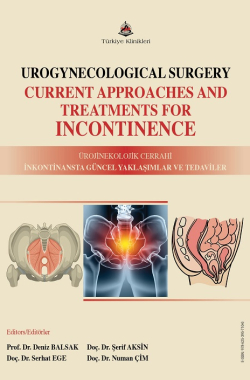ENDOMETRIOSIS AND UROGYNECOLOGY
Uğurcan Dağlı
University of Health Sciences, Tepecik Training and Research Hospital, Department of Gynecology and Obstetrics, İzmir, Türkiye
Dağlı U. Endometriosis and Urogynecology. In: Balsak D, Çim N, Ege S editors. Urogynecological Surgery Current Approaches and Treatments for Incontinence. 1st ed. Ankara: Türkiye Klinikleri; 2025. p.61-67.
ABSTRACT
Endometriosis is a chronic, estrogen-dependent inflammatory disease characterized by the presence of endometrial-like tissue outside the uterus. It affects approximately 10-20% of women, predominantly during reproductive years, and most commonly presents with pelvic pain and infertility. Deep infiltrating endometriosis (DIE), the most severe form of the disease, is defined by the invasion of endometriotic lesions more than 5 mm below the peritoneal surface. DIE frequently involves pelvic structures such as the uterosacral ligaments, rectovaginal septum, bladder, ureters, and bowel, resulting in complex clinical manifestations.
Urogynecological involvement occurs in approximately 6% of DIE cases, with the bladder and ureters being the most commonly affected organs. Such involvement may lead to symptoms including dysuria, hematuria, pelvic pain, hydronephrosis, and even loss of renal function. Transvaginal ultrasonography is the first-line imaging modality, but magnetic resonance imaging (MRI) is preferred for the evaluation of deep pelvic lesions. In recent years, artificial intelligence (AI)-assisted imaging analysis systems have enhanced the accuracy and standardization of lesion detection, contributing significantly to diagnostic precision and surgical planning.
Surgical treatment must be individualized based on the anatomical extent and organ involvement of the disease. Surgical options include ureterolysis, segmental ureteral resection, or ureteroneocystostomy for ureteral involvement, and lesion excision or partial cystectomy for bladder endometriosis. Compared to traditional 2D laparoscopy, 3D laparoscopic systems provide superior depth perception and tissue differentiation, particularly benefiting nerve-sparing dissections. Techniques such as the Negrar approach, which emphasize preservation of pelvic autonomic nerves, reduce the risk of postoperative complications and improve functional outcomes.
Postoperative follow-up is essential to monitor renal function and detect recurrence. Adjunctive medical therapy with GnRH analogues or progestins may help reduce recurrence rates. Literature reports postoperative symptomatic improvement in 80-95% of patients undergoing bladder surgery for endometriosis. The integration of multidisciplinary management and advanced technologies in the diagnosis, treatment, and follow-up of DIE is essential to ensure optimal surgical outcomes, patient safety, and long-term quality of life.
Keywords: Endometriosis; Deep infiltrating endometriosis; Urogynecological surgery; Pelvic pain; Infertility
Kaynak Göster
Referanslar
- Kennedy S, Bergqvist A, Chapron C, et al. ESHRE guideline for the diagnosis and treatment of endometriosis. Hum Reprod. 2005;20(10):2698-2704. [Crossref] [PubMed]
- Falcone T, Flyckt-Rebecca R. Clinical management of endometriosis. Obstet Gynecol. 2018;131(3):557-571. [Crossref] [PubMed]
- Carrarelli P, Rocha ALL, Belmonte G, et al. Increased expression of antimüllerian hormone and its receptor in endometriosis. Fertil Steril. 2014;101(5):1353-1358. [Crossref] [PubMed]
- Tosti C, Pinzauti S, Santulli P, Chapron C, Petraglia F. Pathogenetic Mechanisms of Deep Infiltrating Endometriosis. Reprod Sci. 2015;22(9):1053-1059. [Crossref] [PubMed]
- Sinaii N, Cleary SD, Ballweg ML, Nieman LK, Stratton P. High rates of autoimmune and endocrine disorders, fibromy algia, chronic fatigue syndrome and atopic diseases among women with endometriosis: a survey analysis. Hum Reprod. 2002;17(10):2715-2724. [Crossref] [PubMed]
- Becker CM, Bokor A, Heikinheimo O, et al. ESHRE guideline: endometriosis. Hum Reprod open. 2022;2022(2):hoac009.
- Kuznetsov L, Dworzynski K, Davies M, Overton C. Diagnosis and management of endometriosis: summary of NICE guidance. BMJ. 2017;358:j3935. [Crossref] [PubMed]
- Singh S, Soliman AM, Rahal Y, et al. Prevalence, Symptomatic Burden, and Diagnosis of Endometriosis in Canada: Cross-Sectional Survey of 30 000 Women. J Obstet Gynaecol Canada JOGC = J d'obstetrique Gynecol du Canada JOGC. 2020;42(7):829-838. [Crossref] [PubMed]
- Gui B, Valentini AL, Ninivaggi V, Marino M, Iacobucci M, Bonomo L. Deep pelvic endometriosis: Don't forget round ligaments. Review of anatomy, clinical characteristics, and MR imaging features. Abdom Imaging. 2014;39(3):622-632. [Crossref] [PubMed]
- Bazot M, Thomassin I, Hourani R, Cortez A, Darai E. Diagnostic accuracy of transvaginal sonography for deep pelvic endometriosis. Ultrasound Obstet Gynecol Off J Int Soc Ultrasound Obstet Gynecol. 2004;24(2):180-185. [Crossref] [PubMed]
- Abrao MS, Gonçalves MO da C, Dias JAJ, Podgaec S, Chamie LP, Blasbalg R. Comparison between clinical examination, transvaginal sonography and magnetic resonance imaging for the diagnosis of deep endometriosis. Hum Reprod. 2007;22(12):3092-3097. [Crossref] [PubMed]
- Chapron C, Chopin N, Borghese B, et al. Deeply infiltrating endometriosis: pathogenetic implications of the anatomical distribution. Hum Reprod. 2006;21(7):1839-1845. [Crossref] [PubMed]
- Nezhat C, Falik R, McKinney S, King LP. Pathophysiology and management of urinary tract endometriosis. Nat Rev Urol. 2017;14(6):359-372. [Crossref] [PubMed]
- Seracchioli R, Mabrouk M, Montanari G, Manuzzi L, Concetti S, Venturoli S. Conservative laparoscopic management of urinary tract endometriosis (UTE): Surgical outcome and long-term follow-up. Fertil Steril. 2010;94(3):856-861. [Crossref] [PubMed]
- Sundaram M, Munjal R, Patel J. Deep Infiltrating Ureteral Endometriosis with Hydroureteronephrosis: A Case Report. J Obstet Gynaecol India. 2019;69(1):95-96. [Crossref] [PubMed] [PMC]
- Ceccaroni M, Ceccarello M, Clarizia R, et al. Nerve-sparing laparoscopic disc excision of deep endometriosis involving the bowel: a single-center experience on 371 consecutives cases. Surg Endosc. 2021;35(11):5991-6000. [Crossref] [PubMed]
- Guerriero S, Ajossa S, Orozco R, et al. Accuracy of transvaginal ultrasound for diagnosis of deep endometriosis in the rectosigmoid: Systematic review and meta-analysis. Ultrasound Obstet Gynecol Off J Int Soc Ultrasound Obstet Gynecol. 2016;47(3):281-289. [Crossref] [PubMed]
- Koninckx PR, Ussia A, Adamyan L, Wattiez A, Donnez J. Deep endometriosis: definition, diagnosis, and treatment. Fertil Steril. 2012;98(3):564-571. [Crossref] [PubMed]

